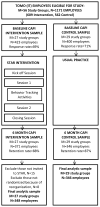Changing Work and Work-Family Conflict: Evidence from the Work, Family, and Health Network*
- PMID: 25349460
- PMCID: PMC4208075
- DOI: 10.1177/0003122414531435
Changing Work and Work-Family Conflict: Evidence from the Work, Family, and Health Network*
Abstract
Schedule control and supervisor support for family and personal life are work resources that may help employees manage the work-family interface. However, existing data and designs have made it difficult to conclusively identify the effects of these work resources. This analysis utilizes a group-randomized trial in which some units in an information technology workplace were randomly assigned to participate in an initiative, called STAR, that targeted work practices, interactions, and expectations by (a) training supervisors on the value of demonstrating support for employees' personal lives and (b) prompting employees to reconsider when and where they work. We find statistically significant, though modest, improvements in employees' work-family conflict and family time adequacy and larger changes in schedule control and supervisor support for family and personal life. We find no evidence that this intervention increased work hours or perceived job demands, as might have happened with increased permeability of work across time and space. Subgroup analyses suggest the intervention brings greater benefits to employees more vulnerable to work-family conflict. This study advances our understanding of the impact of social structures on individual lives by investigating deliberate organizational changes and their effects on work resources and the work-family interface with a rigorous design.
Keywords: experiment; group-randomized trial; organizations; schedule control; work-family conflict.
Figures






References
-
- Acker Joan. Hierarchies, Jobs, Bodies: A Theory of Gendered Organizations. Gender and Society. 1990;4:139–58.
-
- Albiston Catherine R. Institutional Inequality and the Mobilization of the Family and Medical Leave Act: Rights on Leave. New York: Cambridge University Press; 2010.
-
- Allen Tammy D. Family-Supportive Work Environments: The Role of Organizational Perceptions. Journal of Vocational Behavior. 2001;58:414–35.
-
- Allen Tammy D, Armstrong Jeremy C. Further Examination of the Link between Work-Family Conflict and Physical Health: The Role of Health-Related Behaviors. American Behavioral Scientist. 2006;49:1204–21.
-
- Bailyn Lotte. Redesigning Work for Gender Equity and Work-Personal Life Integration. Community, Work & Family. 2011;14:97–112.
Grants and funding
LinkOut - more resources
Full Text Sources
Other Literature Sources
Medical
